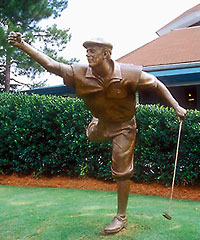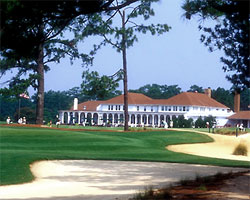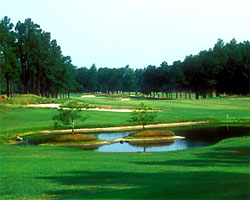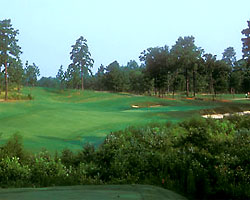A Moment In Time
Golf at The Legendary Pinehurst Resort, North Carolina
by Dale Leatherman Unlike Augusta, at Pinehurst — the home of American Golf and host again to this year's U.S. Open — everyday duffers can pay their greens fees and try their luck where the legends have played.
Unlike Augusta, at Pinehurst — the home of American Golf and host again to this year's U.S. Open — everyday duffers can pay their greens fees and try their luck where the legends have played.
The life-sized bronze of Payne Stewart — fist raised, right leg akimbo, expression proud — captures forever his jubilation as his 15-foot putt dropped into the cup to clinch his victory in the 1999 U.S. Open. The statue overlooks the place where it happened — the 18th green of Pinehurst's legendary No. 2 Course.
Only two golf experiences have caused a lump in my throat. One was standing on the first tee of the Old Course at St. Andrews for the first time. The other was seeing the bronze of Stewart and flashing back to that memorable tournament and the eerie plane ride a few months later that ended in his death.
When the U.S. Open returned to Pinehurst in June 2005, commentators reminded us of Payne's one moment in time — along with other events and players whose memories live on here in the piney woods of North Carolina.
Pinehurst, a National Historic Landmark, is America's St. Andrews, the queen of U.S. golf resorts. This status is not about quantity (the resort has eight courses), but the quality of its golf and the golf experience. We all got a good look at the place from afar during the televised coverage of the 1999 U.S. Open. And we've heard about the historic tournaments played here over the past century, contests that proved to be defining occasions for legends such as Bell, Collett, Dye, Hagen, Hogan, Nelson, Nicklaus, Quimet, Snead and Zaharias.
Just thinking about it is enough to make every red-blooded golfer yearn to set foot on Donald Ross' No. 2 Course — or No. 1, No. 3 or No. 4. Unlike untouchable Augusta, Pinehurst allows the lowliest duffer to have a go at the same fairways and greens where the greats of the game have played. Everyone can find happiness on at least one of the tracks here, layouts that range from diabolical to delightful. Complementing Ross' work is a smorgasbord of designs by Ellis Maples, Robert Trent Jones Sr., Rees Jones and Tom and George Fazio. And these are just on the resort proper; more than 40 venues are scattered throughout the area within a short drive of the Village of Pinehurst.
 It all started with the Village. In 1895 James Tufts, founder of the American Soda Fountain Company in Boston, purchased 5,500 acres of pine forest and sandy meadows for $1 an acre. He charged landscape architect Frederick Law Olmstead, designer of New York's Central Park, with creating a winter retreat for New Englanders. The streets and common areas he laid out remain in a delightful 19th-century time warp, with brick sidewalks shaded by massive trees and flowers bursting from beds at every corner and on the village green. Many of the first buildings built here remain, though they have different uses. The casino is now occupied by a real estate firm, and the general store houses a deli, a café and a clothing store. The first inn, The Holly, opened at the end of 1895. Today the cozy 77-room inn is a National Historic Landmark, and one of three world-class hotels in the Village.
It all started with the Village. In 1895 James Tufts, founder of the American Soda Fountain Company in Boston, purchased 5,500 acres of pine forest and sandy meadows for $1 an acre. He charged landscape architect Frederick Law Olmstead, designer of New York's Central Park, with creating a winter retreat for New Englanders. The streets and common areas he laid out remain in a delightful 19th-century time warp, with brick sidewalks shaded by massive trees and flowers bursting from beds at every corner and on the village green. Many of the first buildings built here remain, though they have different uses. The casino is now occupied by a real estate firm, and the general store houses a deli, a café and a clothing store. The first inn, The Holly, opened at the end of 1895. Today the cozy 77-room inn is a National Historic Landmark, and one of three world-class hotels in the Village.
The Carolina, an elegant 210-room hotel with grand, high-ceilinged common areas, opened in 1901. It was quickly dubbed "Queen of the South" and the "White House of Golf" and began attracting wealthy families such as the Rockefellers, Morgans and DuPonts. Opened in 1923, the 45-room Manor continues to offer casual accommodations and a great place for après golf celebrations — Hacker's sports bar.
Today's visitors can opt for lodging in the hotels or a selection of villas and condos. I personally favor The Holly. Its homey rooms are the perfect blend of history and modern comforts, and the 1895 Room offers a sublime dining experience. It's a short walk from The Holly to restaurants in The Carolina and The Manor, as well as village shops and restaurants and the new 31,000-square-foot spa, which has an indoor pool.
The idea of golf at Pinehurst did not originate with Tufts, but with his guests. At the turn of the century, the game was in its infancy in the U.S. and many of the resort's well-heeled patrons had begun to dabble in it. When Tufts got an angry complaint from a dairy farmer that his guests were hitting little white balls into his pasture and frightening his cows, the savvy resort owner built a nine-hole course. A visiting congressman advised against building another nine holes because golf was "a passing fancy," but Tufts built not only another nine but a clubhouse with dressing rooms for men and women.
In 1900, Scottish-born Donald Ross was hired as the resort's golf professional. His tenure would stretch to 48 years and have an immeasurable impact on the American golf scene. Ross designed four courses at Pinehurst and was responsible for 400 more throughout the country.
 Any discussion of Pinehurst golf naturally begins with No. 2, a 7,252-yard par 72 (74 for women). It is played as golf was meant to be — walking with a caddy. You can take a cart, but the paths are so far away it's too difficult and distracting. There's an excellent case for playing it in spring or fall rather than walking it in the heat of summer.
Any discussion of Pinehurst golf naturally begins with No. 2, a 7,252-yard par 72 (74 for women). It is played as golf was meant to be — walking with a caddy. You can take a cart, but the paths are so far away it's too difficult and distracting. There's an excellent case for playing it in spring or fall rather than walking it in the heat of summer.
Phil Mickelson calls No. 2 ". . .the best test of golf I've played in a major championship. Other U.S. Open courses have taken the drive out of your hands, forced you to hit two- and three- and four-irons off the tee. Others make the short game obsolete. Here, with all the options around the greens, the short game is an integral part of the championship."
Tiger Woods puts it succinctly: "From tee to green this course is fairly simple. Around the greens it is very complicated."
Complicated. As in fast, crowned greens with false fronts that send your fine chip shot rolling back into a bunker. Fairways that look generous but are mined with bunkers and waste areas. Any one with higher than a 15 handicap should probably forego this test, but how can one resist? I won't forget playing the finishing holes late in the day as the carillon played from the village chapel and a pair of mockingbirds conducted a verbal duel over territory. On the 18th green, when my ball finally found the cup, I raised a fist in salute to Stewart.
No. 1, a 6,128-yard, par 70 (73 for women) from a kindler, gentler Ross, is a good warm-up, and its length is not to be taken too lightly. The designer will make you pay dearly for sloppy play. Another good warm-up is No. 3, a short par 70 (71 for women) playing 5682 or 5232 yards, with fast greens and plenty of trouble.
On No. 4, site of the 2008 U.S. Amateur Championship, only the routing is a Ross original, though you may think otherwise on the first green, which is as wickedly domed as anything on No. 2. In 2000, No. 4 opened as a totally new Tom Fazio design that is visually stunning and almost impossible to navigate without spending time in a pot bunker or two. There are about 140 of them, and it's not only bad shots that are penalized. The lake holes, thirteen and fourteen, are particularly scenic. No. 4 is a 7,117-yard par 72.
You'll find more water hazards on No. 5 than any other course at Pinehurst. The 6,848-yard, par 72 track is a 1961 Ellis Maples design (revamped in 1974) that demonstrates Ross' tenet that Nature is the best architect. Without moving a lot of dirt, Maples crafted an interesting test full of variety in elevation, pitch and hole length.
No. 6 reopened March 2005 as a championship course, having been aggressively revisited by Tom Fazio. It emerged with all new bunkering and greens reshaped and planted in Penn G-2 bentgrass, the standard now on all the resort's layouts. There's more roll to the terrain here, creating a stiffer challenge off the tee. The back nine on this 7,008-yard par 71 (72 for women) is particularly tough.
The Rees Jones-designed No. 7 has the highest slope rating of the eight and is one of the most dramatic. It's located one mile from the main clubhouse on a particularly rugged piece of land that gives it qualities more prevalent on mountain courses than in the mostly flat Sandhills. There are frequent wetland encounters and great expanses of sand along the way, culminating in big, rolling greens. No. 7 plays 7,216 yards from the tips. A bit of history: the old employee nine-holer was here; some bunkers remain around the fourth tee.
 Fazio borrowed from Ross' design book in crafting No. 8, which opened in 1996, the resort's centennial year. The greens are trouble — sloping, false-fronted and ringed by swales and dips — but lack the severe crowning of No. 2. There's no lack of Fazio in the design, which tracks through a restless piece of wilderness with marshes, tall wild grasses, hardpan waste areas and hidden bunkers. The birds love it and so did I, especially the spectacular back nine, which surprises at every turn. No. 8 plays 7,092 yards to a par of 72.
Fazio borrowed from Ross' design book in crafting No. 8, which opened in 1996, the resort's centennial year. The greens are trouble — sloping, false-fronted and ringed by swales and dips — but lack the severe crowning of No. 2. There's no lack of Fazio in the design, which tracks through a restless piece of wilderness with marshes, tall wild grasses, hardpan waste areas and hidden bunkers. The birds love it and so did I, especially the spectacular back nine, which surprises at every turn. No. 8 plays 7,092 yards to a par of 72.
Regardless of which courses you play, after a round the spell of golf lingers, as if there is no other reality in the world beyond this ancient game. It follows you not just to the clubhouse bar for a rehash and settling of bets over beers, but to your hotel, where the doorman asks not "how was your day" but how you played. It follows you as you stroll the village streets on the way to dinner, smiling at others with telltale "raccoon" tans from long days in sunglasses. Wherever you dine you will hear snatches of conversation from neighboring tables about the almost-birdie putt or the miraculous chip or the course to be played tomorrow.
For most visitors, golf is their raison d'être. Being in Pinehurst means total immersion in the game, from the historic photos, plaques and trophies along the clubhouse's Heritage Hall to the everyday reality of the missed three-foot putt.
Pinehurst is not the birthplace of American golf, but it is, without a doubt, the Home of American Golf. It is our St. Andrews. As Tom Watson said, "Pinehurst reminds me of a quote I read not long ago: 'Golf is not a matter of life and death to these people. It's more important than that.'"
Located in south central North Carolina, Pinehurst is 60 miles southwest of Raleigh. Five regional airports are nearby. For more information, call 800-487-4653 or visit www.pinehurst.com
photos by Donnelle Oxley

